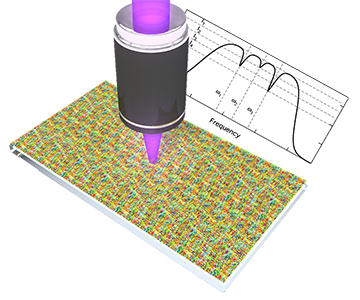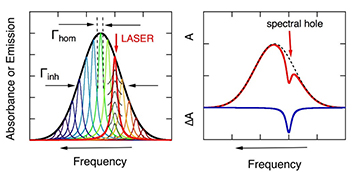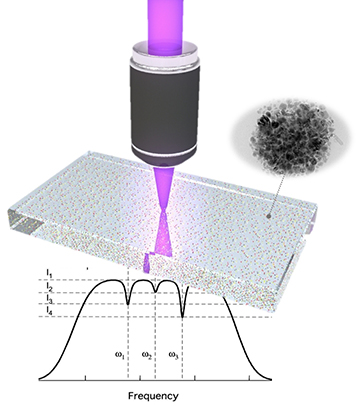
A research team in Australia has prototyped a system that could substantially increase the storage capacity of optical disks, by making the method of “persistent spectral-hole burning” potentially practical at room temperatures. [Image: Courtesy of N. Riesen]
The dizzying growth in the world’s data—from vast scientific archives to your grandmother’s thousands of digital photos—is increasingly creating a quandary: how to store all of the stuff. Magnetic and solid-state drives, the staples of today’s personal computers and smart devices, remain the go-to technologies for high-performance, rapid-access data storage. But these approaches quickly become costly for long-term, “cold” data storage at the scale of hundreds to thousands of terabytes or more.
In recent years, those economics have caused some Silicon Valley firms to take another look at optical data storage. Since the mid-2010s, Facebook, for example, has experimented with a familiar optical technology, Blu-Ray disks, for archival data storage. But even these inexpensive optical disks are limited in their ultimate capacity. Standard Blu-Ray disks, for example, top out at 25 to 125 GB apiece, though recently that’s been pushed several hundred gigs higher with specialized signal processing and readout equipment.
Researchers at several universities in Australia are now working on a technology that they say could kick up those data capacities by several orders of magnitude (ACS Photon., doi: 10.1021/acsphotonics.1c01115). The result, the team believes, could be optical disks storing tens to hundreds of terabytes of data apiece. That vision, if realized, might provide a much more scalable, low-cost optical alternative to conventional data storage.
Spectral-hole burning, revisited
The new work, led by Nicolas Riesen of the University of South Australia and the University of Adelaide, leverages a technique to boost optical storage capacity that has been in the literature for nearly four decades: so-called persistent spectral-hole burning. The technique works by encoding binary data as a series of “holes” in the frequency spectrum of a phosphorescent material used as the storage medium.
Persistent spectral-hole burning relies on the fact that, at the scale of a diffraction-limited laser spot, a typical solid-state phosphor material—because of local variations and imperfections—will have a broad, inhomogeneous absorption frequency spectrum. That broader inhomogeneous line, in turn, represents the superposition of much narrower, homogeneous lines of different frequencies.

In persistent spectral-hole burning, a laser resonant at a narrow frequency within a broader, inhomogeneous frequency distribution of a material (left) can photoionize or otherwise photochemically change the material, leaving a narrow spectral “hole” at that material (right). The hole can serve, effectively, as a 0 or 1 in binary data storage. [Image: Courtesy of N. Riesen]
When a narrowband, diffraction-limited laser spot tuned to a specific frequency within the inhomogeneous distribution illuminates the phosphor, it can photoionize or otherwise induce a permanent photochemical change in the material. The result is effectively to burn a narrow dip in the inhomogeneous frequency spectrum. That spectral hole can later be sensed by another laser—potentially providing a system for writing and reading digital data.
Multi-bit encoding
The power of persistent spectral-hole burning is that, by leveraging the frequency dimension, it potentially allows the encoding of far more information within the area of a diffraction-limited laser spot. Using multiple lasers, or sweeping a single laser through multiple frequencies, can potentially write numerous spectral holes within the spot, each of them representing a binary 0 or 1 of digital data.
Just how much information is determined by how many narrow, homogeneous frequency linewidths are crowded in to make up the material’s broader inhomogeneous linewidth. And there’s the rub. At cryogenic, liquid-helium temperatures, the ratio of the inhomogeneous to the homogeneous linewidth can be very large indeed—on the order of a million—providing ample room to write many bits of data within a single laser spot. But as systems approach more practical room temperatures, the homogeneous linewidths broaden and prevent narrow holes from being burnt into the inhomogeneous spectrum.
“Top-hat” frequency distribution
To try to get around this operating-temperature quandary, Riesen and his team—which also included researchers at the University of New South Wales—focused on developing the right phosphor for the job. They settled on a physical mixture of a variety of chemically different matlockite nanocrystals with different resonance frequencies. “Even at the diffraction limit,” according to Riesen, “the laser spot is going to be much larger than the nanocrystals, which are about 30 nm or so in size.”

The team used a physical mixture of chemically diverse, phosphorescent nanocrystals to create a broad “top hat” frequency distribution that could support the creation of multiple spectral holes in a single laser spot—even at room temperature. The team believes that the method, if scaled up, could vastly increase optical data storage capacities—especially when a range of hole depths is used to increase the bit density, through multilevel encoding. [Image: Courtesy of N. Riesen] [Image: Courtesy of N. Riesen]
As a result, he says, the laser “sees” a broad inhomogeneous spectrum similar to a flattened “top hat” in shape. And that top-hat distribution, he explains, substantially boosts the number of spectral holes, and thus bits, that can potentially be burnt into the spectrum for later retrieval—even at room temperature.
What’s more, by varying the laser intensity, and thus the depths of the spectral holes in the top-hat distribution, there’s the possibility of storing multiple bits in a single hole, according to Riesen. For example, if four discrete levels are possible for a given spectral hole—corresponding to 00, 01, 10 and 11—two bits can be stored with that single hole, with the specific values dependent on the hole depth.
“This is multi-level encoding,” says Riesen. “You’re able to store a lot more information on a given surface area.”
Testing the system
The team tested out the system by developing a custom-tailored nanocrystal mix—which, Riesen says, required “a bit of trial and error” to optimize the top-hat frequency distribution—and then putting the mixture into a polymer binder to create a thin film. The researchers next spread the film onto a plastic substrate, and used a digitally controlled external-cavity diode laser to burn two spectral holes at different frequencies within the same laser spot at room temperature (295 K). They also used the same system to burn spectral holes at multiple depths by varying the laser intensity.
Those experiments, Riesen says, provided “a basic proof of concept that the idea is sound,” and that the system can be used to encode multiple bits within a single laser spot at room temperature. The team also showed that a substantially larger number of spectral holes could be burned if the material was cooled to around 175 K. That’s an easy level to achieve with thermoelectric cooling, and much more potentially practical than the frigid liquid-helium temperatures required for most previous spectral-hole-burning storage schemes.
Leveraging existing technologies
Based on this proof of concept, Riesen’s team believes that the technique could eventually scale to allow data densities on the order of terabits/cm2 in a 2D storage system (such as an optical disk), or tens to hundreds of terabits/cm3 in a 3D system. Those densities, if realized, would go several orders of magnitude beyond what’s possible with existing, non-cryogenic optical storage.
As one possibility, Riesen envisions adapting current systems by applying the thin nanocrystal film to existing optical disk platforms. “It would be a thin layer of this phosphor film on a plastic disk,” he says. “So it could use some of the existing readout technologies already out there, which is a big advantage.” The team is now working on refining the system, and seeking investment partners to move beyond the initial proof of concept to something “more commercially ready.”
